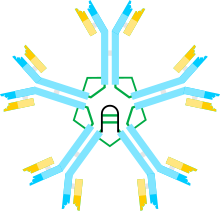| Hyper IgM syndrome | |
|---|---|
 | |
| Immunoglobulin M | |
| Specialty | Immunology |
| Symptoms | Chronic diarrhea[1] |
| Types | Hyper-IgM syndrome type 1, 2, 3, 4 and 5[2][3][4][5][6] |
| Diagnostic method | MRI, Chest radiography[1] |
| Treatment | Allogeneic hematopoietic cell transplantation[7] |
Hyper IgM syndrome is a rare primary immune deficiency disorders characterized by low or absent levels of serum IgG, IgA, IgE and normal or increased levels of serum IgM.[8]
They are resulting from mutations in the pathway from B-cell activation to isotype class switching. Patients with HIGM are usually diagnosed within the first two years of life and experience severe immunosuppression. This syndrome is also known as immunoglobulin class switch recombination (Ig-CSR) deficiencies.[9] The most common causes are mutations in the CD40 Ligand (CD40LG) gene located at Xq26.3-27 leading to X-linked HIGM (XHIGM) in males.[10]
- ^ a b Cite error: The named reference
emedwas invoked but never defined (see the help page). - ^ Cite error: The named reference
om1was invoked but never defined (see the help page). - ^ Cite error: The named reference
om2was invoked but never defined (see the help page). - ^ "OMIM Entry – # 606843 – IMMUNODEFICIENCY WITH HYPER-IgM, TYPE 3; HIGM3". omim.org. Retrieved 16 November 2016.
- ^ Cite error: The named reference
om5was invoked but never defined (see the help page). - ^ "OMIM Entry – 608184 – IMMUNODEFICIENCY WITH HYPER-IgM, TYPE 4; HIGM4". omim.org. Retrieved 2 January 2018.
- ^ Cite error: The named reference
genwas invoked but never defined (see the help page). - ^ Yazdani, Reza; Fekrvand, Saba; Shahkarami, Sepideh; Azizi, Gholamreza; Moazzami, Bobak; Abolhassani, Hassan; Aghamohammadi, Asghar (1 January 2019). "The hyper IgM syndromes: Epidemiology, pathogenesis, clinical manifestations, diagnosis and management". Clinical Immunology. 198: 19–30. doi:10.1016/j.clim.2018.11.007. ISSN 1521-6616. S2CID 53566466.
- ^ Jhamnani, Rekha D.; Nunes-Santos, Cristiane J.; Bergerson, Jenna; Rosenzweig, Sergio D. (2018). "Class-Switch Recombination (CSR)/Hyper-IgM (HIGM) Syndromes and Phosphoinositide 3-Kinase (PI3K) Defects". Frontiers in Immunology. 9. doi:10.3389/fimmu.2018.02172. ISSN 1664-3224. PMC 6168630. PMID 30319630.
- ^ Leven, Emily A.; Maffucci, Patrick; Ochs, Hans D.; Scholl, Paul R.; Buckley, Rebecca H.; Fuleihan, Ramsay L.; Geha, Raif S.; Cunningham, Coleen K.; Bonilla, Francisco A.; Conley, Mary Ellen; Ferdman, Ronald M.; Hernandez-Trujillo, Vivian; Puck, Jennifer M.; Sullivan, Kathleen; Secord, Elizabeth A. (July 2016). "Hyper IgM Syndrome: a Report from the USIDNET Registry". Journal of Clinical Immunology. 36 (5): 490–501. doi:10.1007/s10875-016-0291-4. ISSN 0271-9142. PMC 5039943. PMID 27189378.